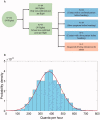Transmission of SARS-CoV-2 during air travel: a descriptive and modelling study
- PMID: 34463165
- PMCID: PMC8409939
- DOI: 10.1080/07853890.2021.1973084
Transmission of SARS-CoV-2 during air travel: a descriptive and modelling study
Abstract
Objectives: To explore the potential of SARS-CoV-2 spread during air travel and the risk of in-flight transmission.
Methods: We enrolled all passengers and crew suspected of being infected with SARS-CoV-2, who bounded for Beijing on international flights. We specified the characteristics of all confirmed cases of COVID-19 infection and utilised Wells-Riley equation to estimate the infectivity of COVID-19 during air travel.
Results: We screened 4492 passengers and crew with suspected COVID-19 infection, verified 161 confirmed cases (mean age 28.6 years), and traced two confirmed cases who may have been infected in the aircraft. The estimated infectivity was 375 quanta/h (range 274-476), while the effective infectivity was only 4 quanta/h (range 2-5). The risk of per-person infection during a 13 h air travel in economy class was 0.56‰ (95% CI 0.41‰-0.72‰).
Conclusion: We found that the universal use of face masks on the flight, together with the plane's ventilation system, significantly decreased the infectivity of COVID-19.KEY MESSAGESThe COVID-19 pandemic is changing the lifestyle in the world, especially air travel which has the potential to spread SARS-CoV-2.The universal use of face masks on the flight, together with the plane's ventilation system, significantly decreased the infectivity of COVID-19 on an aircraft.Our findings suggest that the risk of infection in aircraft was negligible.
Keywords: COVID-19; SARS-CoV-2; air travel; aircraft; infectious diseases; transmission.
Conflict of interest statement
The authors declare that they have no competing interests.
Figures



Similar articles
-
Air travel and COVID-19 prevention in the pandemic and peri-pandemic period: A narrative review.Travel Med Infect Dis. 2021 Jan-Feb;39:101915. doi: 10.1016/j.tmaid.2020.101915. Epub 2020 Nov 10. Travel Med Infect Dis. 2021. PMID: 33186687 Free PMC article. Review.
-
Absence of in-flight transmission of SARS-CoV-2 likely due to use of face masks on board.J Travel Med. 2020 Dec 23;27(8):taaa117. doi: 10.1093/jtm/taaa117. J Travel Med. 2020. PMID: 32662832 Free PMC article. No abstract available.
-
In-flight transmission of SARS-CoV-2: a review of the attack rates and available data on the efficacy of face masks.J Travel Med. 2020 Dec 23;27(8):taaa178. doi: 10.1093/jtm/taaa178. J Travel Med. 2020. PMID: 32975554 Free PMC article.
-
Transmission of SARS-CoV 2 During Long-Haul Flight.Emerg Infect Dis. 2020 Nov;26(11):2617-2624. doi: 10.3201/eid2611.203299. Epub 2020 Sep 18. Emerg Infect Dis. 2020. PMID: 32946369 Free PMC article.
-
Transmission of SARS-CoV-2 associated with aircraft travel: a systematic review.J Travel Med. 2021 Oct 11;28(7):taab133. doi: 10.1093/jtm/taab133. J Travel Med. 2021. PMID: 34480171 Free PMC article.
Cited by
-
Air Passengers' Risk of SARS-CoV-2 Infection With a 14-Day Quarantine and Accuracy Assessment of a Symptom-based Screening System at an Airport.J Prev Med Public Health. 2025 Jan;58(1):72-82. doi: 10.3961/jpmph.24.517. Epub 2024 Nov 3. J Prev Med Public Health. 2025. PMID: 39638300 Free PMC article.
-
A theoretical epidemiological investigation into the transmission of respiratory infectious diseases during group meals among military personnel based on an individual-based model.Front Public Health. 2025 May 21;13:1545938. doi: 10.3389/fpubh.2025.1545938. eCollection 2025. Front Public Health. 2025. PMID: 40469601 Free PMC article.
-
SARS-CoV-2 Cases Reported on International Arriving and Domestic Flights: United States, January 2020-December 2021.Am J Public Health. 2023 Aug;113(8):904-908. doi: 10.2105/AJPH.2023.307325. Epub 2023 Jun 15. Am J Public Health. 2023. PMID: 37319391 Free PMC article.
-
The emission and dynamics of droplets from human expiratory activities and COVID-19 transmission in public transport system: A review.Build Environ. 2022 Jul 1;219:109224. doi: 10.1016/j.buildenv.2022.109224. Epub 2022 May 24. Build Environ. 2022. PMID: 35645454 Free PMC article. Review.
-
Bioaerosol distribution characteristics and potential SARS-CoV-2 infection risk in a multi-compartment dental clinic.Build Environ. 2022 Nov;225:109624. doi: 10.1016/j.buildenv.2022.109624. Epub 2022 Sep 22. Build Environ. 2022. PMID: 36164582 Free PMC article.
References
Publication types
MeSH terms
LinkOut - more resources
Full Text Sources
Medical
Miscellaneous
